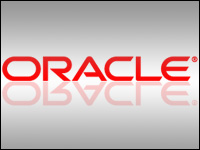
Business software giant Oracle blew past Wall Street targets for profit and revenue in its third quarter, with demand for many of its applications lending further support to its massive acquisition spree.
The company’s results also may help ease investor concern about the health of technology spending inside businesses around the world and the outlook for the rest of 2007, with recent profit-target misses from SAP helping to cloud the tech sector forecast.
Redwood Shores, Calif.-based Oracle said it earned US$1.03 billion, or 20 cents per share, in the quarter that ended in February, a 35 percent increase over the year before. Revenue came in at $4.4 billion, up 25 percent. Both figures were ahead of consensus estimates from analysts.
Highlighting Growth
Oracle executives were quick to highlight the company’s robust growth in its applications business and contrasting its own growth rates with those of key competitors. New license revenue for application software surged higher by 57 percent to $423 million, while database and middleware license revenue rose 10 percent to $967 million.
“We exceeded guidance on every metric, with strong revenue growth across all product lines and in all geographies,” said President and CFO Safra Catz.
Oracle is now 11 quarters into a five-year plan to boost results by 20 percent per year, she noted. “We are delivering earnings growth comfortably ahead of that target, Catz added.
CEO Larry Ellison said Oracle’s middleware new license growth rate of 82 percent compared to an 8 percent growth rate for rival BEA, while Charles Phillips, who also holds the president title at Oracle, said new license sales for applications rose 57 percent in the quarter, compared to SAP’s reported growth rate of 7 percent.
“It took us five years to pass BEA, but we did it,” Ellison said during a conference call to discuss the results. “We have a good chance to overtake SAP. We’re gaining on them consistently and rapidly.”
Strategy Validated
Ellison has led the charge to turn Oracle from a pure-play database company into a sprawling vendor of middleware products, which enable business users to access and manipulate stored data, and applications that control business processes such as payroll and industry-specific tasks.
The multi-year acquisition spree has seen Oracle lay out some $20 billion to acquire major business application software firms, such as Siebel Systems and PeopleSoft, sometimes battling with shareholders, executives and regulators to make deals happen.
Though the bulk of the buys took place two years ago or more, Oracle has signaled it’s not done buying, earlier this month purchasing business intelligence software maker Hyperion for $3.3 billion.
The company indeed is still interested in acquisitions and is focusing on leaders in certain industry verticals, Ellison stated. “Are we tempted to do more? The answer is of course, yes,” he said. “We like to buy category leaders.”
Oracle stock rose nearly 4 percent in morning trading Wednesday in the wake of the results, to $18.18 per share.
In the conference call, Catz also denied reports that Oracle’s sales data had been skewed by a small number of massive software deals in the $100 million range.
Mixed Signals?
Oracle’s outlook was robust as well, with Catz saying that new software license revenue growth in the fourth quarter would be between 5 and 15 percent and overall revenue, which includes services and support contracts, would be up 10 percent year-over-year. The fourth quarter is historically one of the strongest for Oracle.
Oracle also has designs on building a strong Linux business, Ellison explained. “We’re not going to build a Linux business overnight, but we will build it. We’re determined to offer the best support in the world,” he said.
Nevertheless, Oracle has yet to fully integrate its various acquisitions and it has been criticized that its product menu remains a hodge-podge of formerly stand-alone offerings.
In many cases, Oracle has bought companies that offer the same products it already had on the market. That is the case with Hyperion, Gartner analyst Bill Hostman told the E-Commerce Times.
“The major deals can create uncertainty about the future road map for the company’s products,” he noted. “Some customers may have been considered both products and this creates a possibility for confusion.”
While the results indicate customers do not appear to be daunted by the product roll-up strategy or the future changes that may yet occur, the real test may lie ahead for Oracle, as the acquisition-driven growth begins to slow.






















































Social Media
See all Social Media